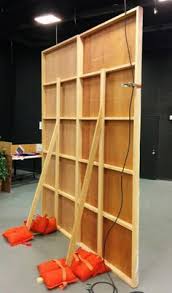Submitted by Mark Steenbarger of Echoeffectarts.com.
Concept:
Brief dramatic use of a live acted scene to help a message stick. The scene only brings up questions, and does not resolve anything.
How it Works:
This approach is to use a drama that does NOT resolve the story. For this type of project to be effective it can only bring something to mind and nothing more. The message / talk will bring the resolution. This could work with many art forms in many different scenarios.
Here’s a specific example :
After the worship set, a faux wall is revealed on stage, representing a wall in a room in a home. (It’s about 8’x 6′) Maybe a chair and a lamp is there to make it look more like a room.
A man enters whistling to himself, carrying a hammer, nails and framed pictures that he is going to hang.
To hang the first picture the man holds the nail in place, hitting it with the hammer once or twice (making noise), then on his last swing he misses and punches a hole in the wall. He reacts verbally, then looks at his pictures and chooses one large enough to cover the hole, then makes a satisfied noise.
He moves over on the wall to hang the next picture, humming or whistling along. He Again hits the nail a time or two, then misses, creating an even larger hole. He reacts, chooses a larger picture, then hangs it to cover the whole, and makes a satisfied noise. He stands back with his hands on this hips to admire his work. The wife’s voice comes from off stage, “How’s it look, honey?”
“Perfect!” he says, picks up his tools and walks off, possibly humming or whistling.
The teaching pastor immediately takes the stage, welcomes everyone and starts his message, not mentioning the scene. At this point, the congregation is trying to reconcile what just happened; why did it that scene just take place, what is the point? Questions remain unanswered.
The pastor works his way to a point about living an authentic life, or being honest with God and others about brokenness, or a similar thought. As he brings the message home he goes to the wall, removes the pictures to reveal the holes, and asks a question that ties the message and scene together, like, “Are you tired of covering up your brokenness?” or similar, and offers an invitation to ministry.
Result:
The result is a “sticky” message that has a sensory connection; the pounding of the hammer, the drama of the on-stage action, and the questions that linger before the tie-in. People often remember such messages years later.
Details:
Scene:
- Must create a knowledge gap.The scene doesn’t resolve until the end of the service.
- Short in length (less than 5 minutes).
- Keep it simple and snappy.
- Start in the middle. No backstory is needed.
 Construction:
Construction:
- For this particular project we simply built a faux wall that was roughly 8′ x 6′, framed with 2x4s, then covered with thick colored paper. You’ll need supporting 2 x 4s to hammer the picture nails into.
- If you are handy with construction and wanted to go to the trouble you could even use real drywall, mount it to your wall frame, and score the back of it to break away when it is hit with the hammer.
- Make sure there is a supporting 2 x 4 placed to hang the pictures on.
- Here is a link to images for building free-standing stage walls.
- It’s best to have at least two pairs of hands working on this.
Materials Needed:
2 x 4’s, screws or nails, roll of thick paper or drywall. (If drywall, then all the materials required to finish and paint it, as well.)
At least three framed pictures of increasing size.
Possibly a chair, lamp, rug, to make it seem more like a room.
Lav mic for the man.
Tools:
Electric saw, hammer, level.
This project is based on an idea by Mark Steenbarger.
mark (at) pointofviewstory.com
Echo Effect Arts, Inc (echoeffectarts.com)


